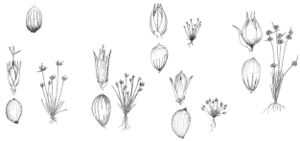Difference between revisions of "Juncus triformis"
2:492. 1868.
imported>Volume Importer |
imported>Volume Importer |
||
| Line 64: | Line 64: | ||
|publication year=1868 | |publication year=1868 | ||
|special status=Illustrated;Endemic;Conservation concern | |special status=Illustrated;Endemic;Conservation concern | ||
| − | |source xml=https:// | + | |source xml=https://bitbucket.org/aafc-mbb/fna-data-curation/src/2e0870ddd59836b60bcf96646a41e87ea5a5943a/coarse_grained_fna_xml/V22/V22_188.xml |
|genus=Juncus | |genus=Juncus | ||
|subgenus=Juncus subg. Graminifolii | |subgenus=Juncus subg. Graminifolii | ||
Revision as of 20:29, 5 November 2020
Herbs, annual, cespitose, 0.5–1.5 dm. Culms 2–80, capillary, 0.1–4 mm diam. Leaves 1/5–1/3 height of plant. Inflorescences headlike clusters, each with 1–7 flowers, bracts subtending inflorescence 2–10, ovate to broadly lanceolate, inconspicuous, 0.7–2.4 mm, membranous, apex acute. Flowers: tepals reddish with green central band, linear to lanceolate, 1.9–4.5 × 0.5–1.1 mm; inner series slightly longer than outer, apex acuminate to attenuate; stamens 3, filaments 0.4–1.1 mm, anthers 1–2.2 mm; style persistent, 1–3.2 mm, stigma 0.5–2.5 mm. Capsules reddish, 3-locular, ovoid to ellipsoid or oblate, 1.6–2.5 × 1.1–1.8 mm, usually 1/2 length of tepals. Seeds nearly globose to ellipsoid, 0.3–0.7 mm. n = 18.
Phenology: Flowering and fruiting spring–mid summer.
Habitat: Shallow soil of seepage areas on granite outcrops, such as along stream banks, ditches, around springs
Elevation: 0–2500 m
Discussion
Of conservation concern.
Selected References
None.

